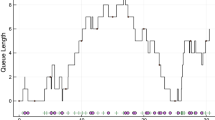Abstract
This paper gives an overview of those aspects of simulation methodology that are (to some extent) peculiar to the simulation of queueing systems. A generalized semi-Markov process framework for describing queueing systems is used through much of the paper. The main topics covered are: output analysis for simulation of transient and steady-state quantities, variance reduction methods that exploit queueing structure, and gradient estimation methods for performance parameters associated with queueing networks.
Similar content being viewed by others
References
S. Asmussen, Conjugate processes and the simulation of ruin problems, Stochastic Process. Appl. 20 (1985) 213–229.
S. Asmussen, Regenerative simulation in heavy traffic, Technical Report, Aalborg University Centre, Denmark, 1987.
K.B. Athreya and P. Ney, A new approach to the limit theory of recurrent Markov chains, Trans. Amer. Math. Soc. 245 (1978) 493–501.
R.E. Barlow and F. Proschan,Statistical Theory of Reliability and Life Testing (Holt, Rinehart and Winston, New York, 1975).
K.W. Bauer, S. Venkataraman and J.R. Wilson, Estimation procedures based on control variates with known covariance matrix,Proc. of the 1987 Winter Simulation Conference (1987) 334–341.
P. Bratley, B.L. Fox and L.E. Schrage,A Guide to Simulation (Springer-Verlag, New York, 1987).
K.L. Chung,Markov Chains with Stationary Transition Probabilities (Springer-Verlag, New York, 1967).
B.L. Fox and P.W. Glynn, Discrete-time conversion for simulating semi-Markov processes, Oper. Res. Lett. 5 (1986) 191–196.
P.W. Glynn, Regenerative simulation of Harris recurrent Markov chains, Technical Report 18, Dept. of Operations Research, Stanford University, Stanford, CA, 1982.
P.W. Glynn, Likelihood ratio gradient estimation: An overview, in:Proc. of the 1987 Winter Simulation Conference (1987) 366–375.
P.W. Glynn and W. Whitt, Efficiency of simulation estimators, In preparation, 1988.
P.W. Glynn and W. Whitt, Sequential stopping in simulation estimation. In preparation, 1988.
P.W. Glynn and W. Whitt, Indirect estimation viaL=λW, Oper. Res. (1988) to appear.
P. Heidelberger and D.L. Iglehart, Comparing stochastic systems using regenerative simulation with common random numbers, Adv. Appl. Prob. 11 (1979) 804–819.
P. Heidelberger, X.-R. Cao, M.A. Zazanis and R. Suri, Convergence properties of infinitesimal perturbation analysis estimates, Manage. Sci. (1988) to appear.
A. Hordijk, D.L. Iglehart and R. Schassberger, Discrete-time methods of simulating continuous-time Markov chains, Adv. Appl. Prob. 8 (1976) 772–788.
S.S. Lavenberg, T.L. Moeller and P.D. Welch, Statistical results on multiple control variables with application to queueing network simulation, Oper. Res. 30 (1982), 182–202.
A.M. Law, Efficient estimators for simulated queueing systems, Manage. Sci. 212 (1975) 30–41.
N. Maigret, Théorme de limite centrale functionnel pour une chaine de Markov rćurrente au sens de Harris et positive, Annales de l'Institut Henri Poincaré B 11 (1978) 187–197.
K.T. Marshall, Some relationships between the distributions of waiting time, idle time and interoutput time in the GI/G/1 queue, SIAM J. Appl. Math. 16 (1968) 324–327.
D.L. Minh and R.M. Sorli, Simulating the GI/G/1 queue in heavy traffic, Oper. Res. 31 (1983) 966–971.
D.L. Minh, Simulating GI/G/k queues in heavy traffic, Manage. Sci. 33 (1987) 1192–1199.
S. Parekh and J. Walrand, Quick simulation of excessive backlogs in networks of queues,Proc. of the 28'th Conference on Decision and Control (1986) 979–986.
D. Revuz,Markov Chains (North-Holland, New York, 1984).
S.M. Ross, Simulating average delay-variance reduction by conditioning,Probability in the Engineering and Informational Sciences (1988) to appear.
R.J. Serfling,Approximation Theorems for Mathematical Statistics (John Wiley, New York, 1980).
D. Siegmund, Importance sampling in the Monte Carlo study of sequential tests, Ann. Stat. 4 (1976) 673–684.
W. Whitt, Continuity of generalized semi-Markov processes, Math. Oper. Res. 5 (1980) 494–501.
W. Whitt, Planning queueing simulations, Manage. Sci. (1988) to appear.
M.A. Zazanis and R. Suri, Comparison of perturbation analysis with conventional sensitivity estimates for stochastic systems, Oper. Res. (1988) to appear.
Author information
Authors and Affiliations
Additional information
The research of this author was supported by the U.S. Army Research Office under Contract DAAG29-84-K-0030.
The research of this author was supported by the U.S. Army Research Office under Contract DAAG29-84-K-0030 and National Science Foundation Grant DCR-85-09668.
Rights and permissions
About this article
Cite this article
Glynn, P.W., Iglehart, D.L. Simulation methods for queues: An overview. Queueing Syst 3, 221–255 (1988). https://doi.org/10.1007/BF01161216
Received:
Issue Date:
DOI: https://doi.org/10.1007/BF01161216




